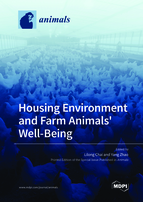Housing Environment and Farm Animals' Well-Being
A special issue of Animals (ISSN 2076-2615). This special issue belongs to the section "Animal Welfare".
Deadline for manuscript submissions: closed (31 March 2022) | Viewed by 42586
Special Issue Editors
Interests: animal environment; poultry housing; precision animal farming; sustainable agriculture
Special Issues, Collections and Topics in MDPI journals
Interests: animal smart sensoring; robotics; behavior monitoring; welfare assessment; airborne transmission of pathogens; and environment management
Special Issues, Collections and Topics in MDPI journals
Special Issue Information
Dear Colleagues,
Housing enviornment affects the health and well-being of farm animals of livestock and poultry raised in concentrated animal feeding operations (CAFOs). Poor air quality (e.g., high levels of indoor ammonia, particulate matter, and airborne bacteria) may deteriorate animals’ health/well-being over time in CAFOs. Mitigating air pollutants generation and suppressing levels of housing air pollutants are critical for maintaining the well-being of farm animals. This special issue of Animals “Housing Environment and Farm Animals' Well-Being” encourages the submission of original research, review, and communication related to livestock and poultry environmental management, air quality control, emissions mitigation, and assessment of animal health and well-being. Publications in this issue will provide references for researchers, students, and animal agriculture producers to enhance on-farm environmental management and animal well-being.
Dr. Lilong Chai
Dr. Yang Zhao
Guest Editors
Manuscript Submission Information
Manuscripts should be submitted online at www.mdpi.com by registering and logging in to this website. Once you are registered, click here to go to the submission form. Manuscripts can be submitted until the deadline. All submissions that pass pre-check are peer-reviewed. Accepted papers will be published continuously in the journal (as soon as accepted) and will be listed together on the special issue website. Research articles, review articles as well as short communications are invited. For planned papers, a title and short abstract (about 100 words) can be sent to the Editorial Office for announcement on this website.
Submitted manuscripts should not have been published previously, nor be under consideration for publication elsewhere (except conference proceedings papers). All manuscripts are thoroughly refereed through a single-blind peer-review process. A guide for authors and other relevant information for submission of manuscripts is available on the Instructions for Authors page. Animals is an international peer-reviewed open access semimonthly journal published by MDPI.
Please visit the Instructions for Authors page before submitting a manuscript. The Article Processing Charge (APC) for publication in this open access journal is 2400 CHF (Swiss Francs). Submitted papers should be well formatted and use good English. Authors may use MDPI's English editing service prior to publication or during author revisions.
Keywords
- farm animals’ environment
- animal health
- livestock well-being
- air quality
- emissions mitigation








